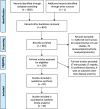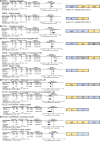Identification of genetic variants associated with dengue or West Nile virus disease: a systematic review and meta-analysis
- PMID: 29929468
- PMCID: PMC6014009
- DOI: 10.1186/s12879-018-3186-6
Identification of genetic variants associated with dengue or West Nile virus disease: a systematic review and meta-analysis
Abstract
Background: Dengue and West Nile viruses are highly cross-reactive and have numerous parallels in geography, potential vector host (Aedes family of mosquitoes), and initial symptoms of infection. While the vast majority (> 80%) of both dengue and West Nile virus infections result in asymptomatic infections, a minority of individuals experience symptomatic infection and an even smaller proportion develop severe disease. The mechanisms by which these infections lead to severe disease in a subset of infected individuals is incompletely understood, but individual host differences including genetic factors and immune responses have been proposed. We sought to identify genetic risk factors that are associated with more severe disease outcomes for both viruses in order to shed light on possible shared mechanisms of resistance and potential therapeutic interventions.
Methods: We applied a search strategy using four major databases (Medline, PubMed, Embase, and Global Health) to find all known genetic associations identified to date with dengue or West Nile virus disease. Here we present a review of our findings and a meta-analysis of genetic variants identified.
Results: We found genetic variations that are significantly associated with infections of these viruses. In particular we found variation within the OAS1 (meta-OR = 0.83, 95% CI: 0.69-1.00) and CCR5 (meta-OR = 1.29, 95% CI: 1.08-1.53) genes is significantly associated with West Nile virus disease, while variation within MICB (meta-OR = 2.35, 95% CI: 1.68-3.29), PLCE1 (meta-OR = 0.55, 95% CI: 0.42-0.71), MBL2 (meta-OR = 1.54, 95% CI: 1.02-2.31), and IFN-γ (meta-OR = 2.48, 95% CI: 1.30-4.71), is associated with dengue disease.
Conclusions: Despite substantial heterogeneity in populations studied, genes examined, and methodology, significant associations with genetic variants were found across studies within both diseases. These gene associations suggest a key role for immune mechanisms in susceptibility to severe disease. Further research is needed to elucidate the role of these genes in disease pathogenesis and may reveal additional genetic factors associated with disease severity.
Keywords: Dengue virus; Disease severity; Genetic variation; Meta-analysis; Single nucleotide polymorphism; West Nile virus.
Conflict of interest statement
Ethics approval and consent to participate
Not applicable. Data sets were extracted without personal identifiers and organized into literature tables.
Consent for publication
Not applicable.
Competing interests
The authors declare that they have no competing interests.
Publisher’s Note
Springer Nature remains neutral with regard to jurisdictional claims in published maps and institutional affiliations.
Figures



Similar articles
-
Infection of mouse neurones by West Nile virus is modulated by the interferon-inducible 2'-5' oligoadenylate synthetase 1b protein.Immunol Cell Biol. 2003 Jun;81(3):230-6. doi: 10.1046/j.1440-1711.2003.01166.x. Immunol Cell Biol. 2003. PMID: 12752688
-
OAS1 polymorphisms are associated with susceptibility to West Nile encephalitis in horses.PLoS One. 2010 May 7;5(5):e10537. doi: 10.1371/journal.pone.0010537. PLoS One. 2010. PMID: 20479874 Free PMC article.
-
Genetic susceptibility to West Nile virus and dengue.Public Health Genomics. 2013;16(1-2):4-8. doi: 10.1159/000345934. Epub 2013 Mar 18. Public Health Genomics. 2013. PMID: 23548711 Review.
-
Genetic variation in OAS1 is a risk factor for initial infection with West Nile virus in man.PLoS Pathog. 2009 Feb;5(2):e1000321. doi: 10.1371/journal.ppat.1000321. Epub 2009 Feb 27. PLoS Pathog. 2009. PMID: 19247438 Free PMC article.
-
Prevalence of chronic comorbidities in dengue fever and West Nile virus: A systematic review and meta-analysis.PLoS One. 2018 Jul 10;13(7):e0200200. doi: 10.1371/journal.pone.0200200. eCollection 2018. PLoS One. 2018. PMID: 29990356 Free PMC article.
Cited by
-
Flying under the radar - impact and factors influencing asymptomatic DENV infections.Front Cell Infect Microbiol. 2023 Nov 24;13:1284651. doi: 10.3389/fcimb.2023.1284651. eCollection 2023. Front Cell Infect Microbiol. 2023. PMID: 38076464 Free PMC article. Review.
-
THE GORDON WILSON LECTURE: THE ETHICS OF HUMAN GENOME EDITING.Trans Am Clin Climatol Assoc. 2020;131:99-118. Trans Am Clin Climatol Assoc. 2020. PMID: 32675851 Free PMC article.
-
Severe West Nile Virus and Severe Acute Respiratory Syndrome Coronavirus 2 Infections in a Patient With Thymoma and Anti-Type I Interferon Antibodies.J Infect Dis. 2025 Feb 4;231(1):e206-e212. doi: 10.1093/infdis/jiae321. J Infect Dis. 2025. PMID: 38976510 Free PMC article.
-
Analytical Approaches to Uncover Genetic Associations for Rare Outcomes: Lessons from West Nile Neuroinvasive Disease.Methods Mol Biol. 2023;2585:193-203. doi: 10.1007/978-1-0716-2760-0_17. Methods Mol Biol. 2023. PMID: 36331775 Free PMC article.
-
Immune system gene polymorphisms associated with severe dengue in Latin America: a systematic review.Rev Inst Med Trop Sao Paulo. 2023 Dec 1;65:e58. doi: 10.1590/S1678-9946202365058. eCollection 2023. Rev Inst Med Trop Sao Paulo. 2023. PMID: 38055376 Free PMC article.
References
-
- Hua RH, Chen NS, Qin CF, Deng YQ, Ge JY, Wang XJ, Qiao ZJ, Chen WY, Wen ZY, Liu WX, et al. Identification and characterization of a virus-specific continuous B-cell epitope on the PrM/M protein of Japanese encephalitis virus: potential application in the detection of antibodies to distinguish Japanese encephalitis virus infection from West Nile virus and dengue virus infections. Virol J. 2010;7:249. doi: 10.1186/1743-422X-7-249. - DOI - PMC - PubMed
Publication types
MeSH terms
Substances
Grants and funding
LinkOut - more resources
Full Text Sources
Other Literature Sources
Medical
Miscellaneous

